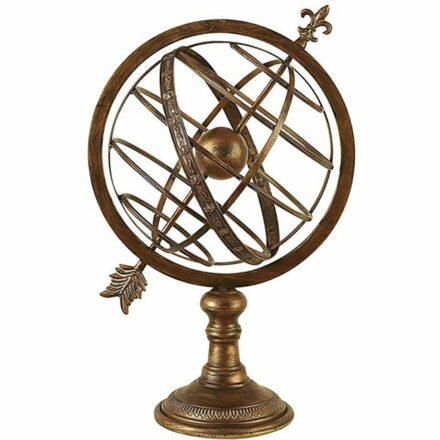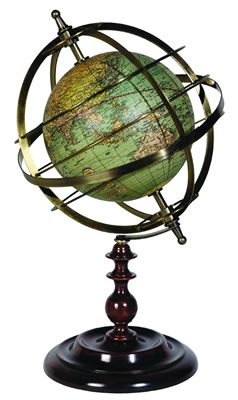I love an armillary. Sculptural, strong, graceful, ancient, and a little mysterious. What did they do with them? I would collect them if I had somewhere to put them. I can’t believe I just said that because that does not necessarily stop me. Thankfully it seems the world is not awash with armillaries, which perhaps enhances their charm. I am almost always delighted to see one.
If only one felt the same about one’s relatives.

I stopped in my tracks when I saw this giant, rustic iron armillary at the East Hampton Antiques Show this summer. Bob Withington from York, Maine, always has the most interesting things, and he did not disappoint in July. The artist is Gary Hume, who builds them from scrap metal and spare parts. Extraordinary.
Here is the website for Withington & Company Antiques, and a very nice piece from a few years ago on The Martha Blog. Yes of course that Martha. Btw in her post Martha makes an excellent point about how taking digital pictures of all the cool things she sees somehow, sometimes alleviates the urge to buy them. Smart cookie.

Armillaria, like everything else, first appeared in China as early as the 3rd century BC, during the Han Dynasty. In Europe they were big in the Middle Ages and the Germans made lots of them as warm-ups for the Volkswagons and BMWs they make now. At one time used to explain the planets and calculate their whereabouts, armillaria are mostly decorative today.

You can read about the armillary and its history in Wikipedia. And if you’re feeling crafty, or looking for a weekend project for the children, here are
instructions on how to make one. This is the construction paper variety, but hey, you could get fancy and use marbleized or metallic paper. Might be fun.

As I quickie-searched the Net, I see I must correct myself. The world, it seems, is somewhat awash in armillaria. eBay had 237 listings. Another site offering a large selection of new ones (and an even larger selection of all things nautical), is The Brass Binnacle, also a great resource for anyone favoring a nautical theme. (I came this close to ordering a a great-looking brass ice bucket made from a porthole.)
Another use for the armillary, the Brass Binnacle points out, is “for life-changing conversations about the historical aspects of the Copernican versus the Ptolemaic view of the universe. Now I have to say I hadn’t thought of that. I also had forgotten what the hell it meant. In case you had too, Ptolemy thought the earth was the center of the universe, and Copernicus came along and said it was the sun.
Today of course a glance at the corner newsstand tells you the center of the universe is Snooki’s baby. I correct myself again.

Update: This just in from my darlin’ cousin in Richmond who is moving into a new house soon and pleased the previous owners are leaving her this armillary they bought in London. The whole thing is pretty darn great, isn’t it?



Isn’t the dealer Bob Withington from York, Maine?
He always has the most fabulous pieces and is so respected by his peers.
Oh Jane thank you, YES. I will put him in immediately. I figured somebody out there would know. Bless you.
Frances – You introduced them to me a few summers ago and it was love at first sight! I look forward to finding the perfect one. Thanks for reminding me. I have my eyes peeled for a purchase.
“Thankfully it seems the world is not awash with armillaries, which perhaps enhances their charm. I am almost always delighted to see one.
If only one felt the same about one’s relatives.”
Truer words were never spoken! Beautiful post, still laughing at the “relatives” quote, bless you!
Thank you, EB, OF COURSE I did not mean MY relatives – tee hee…